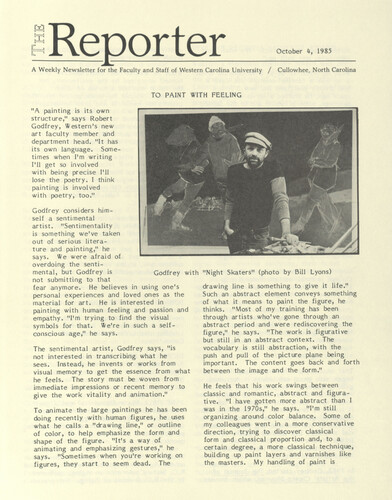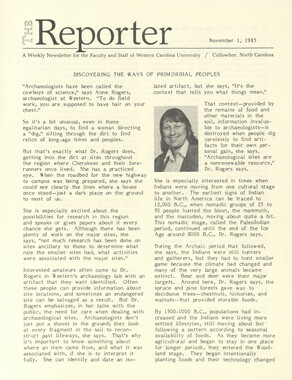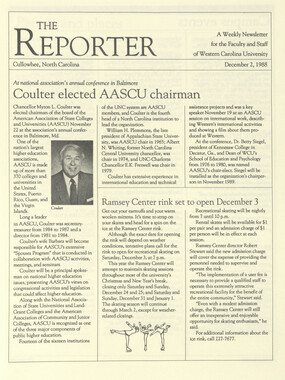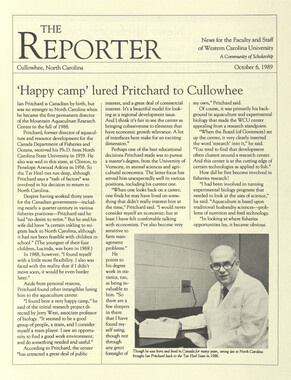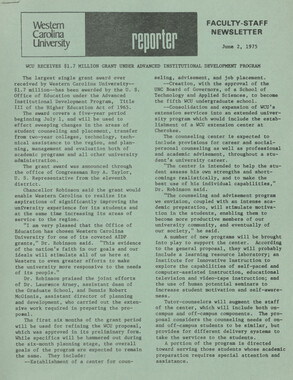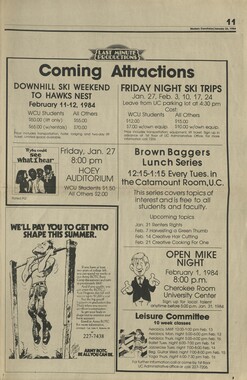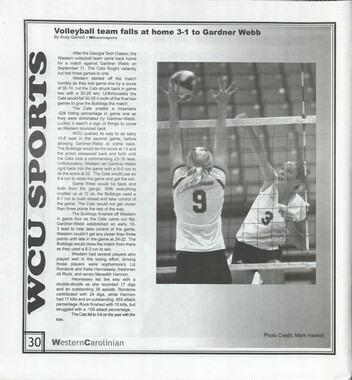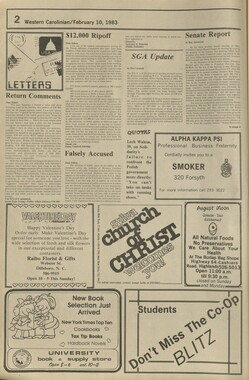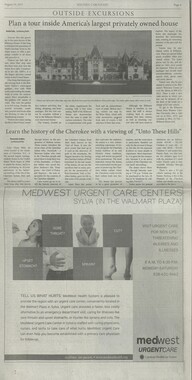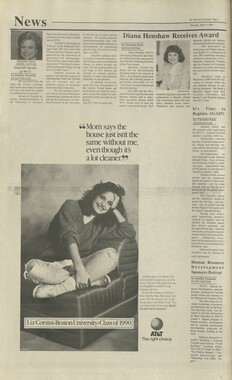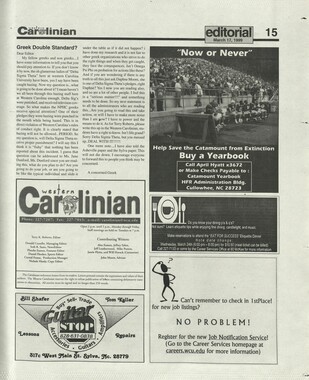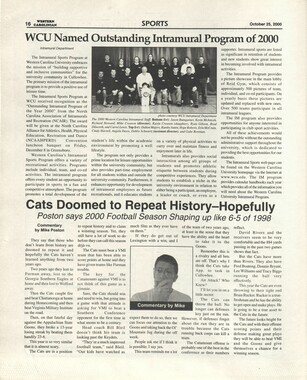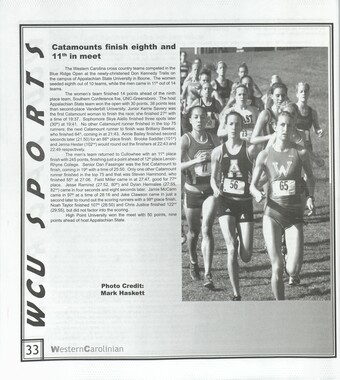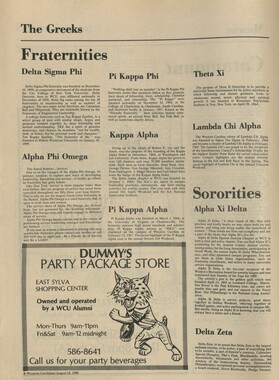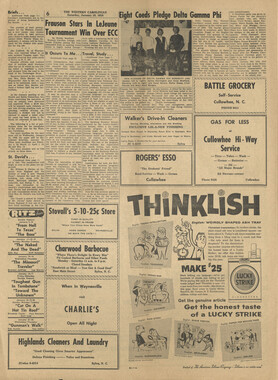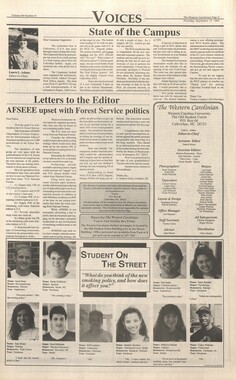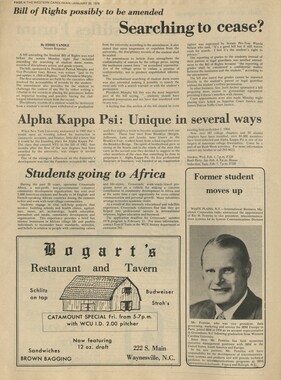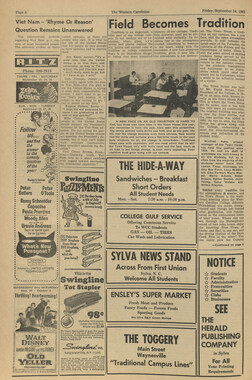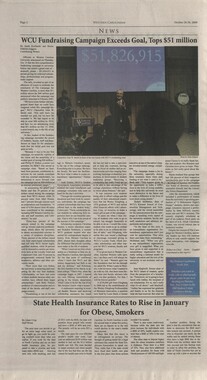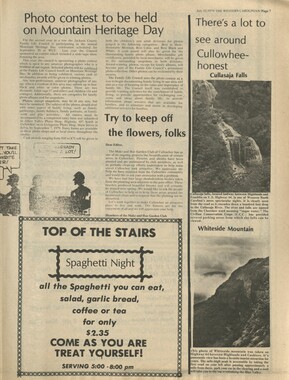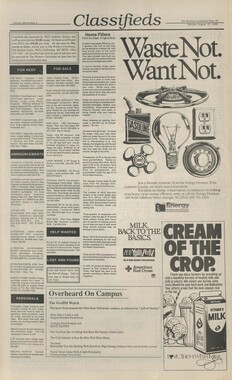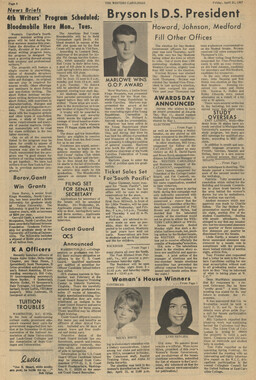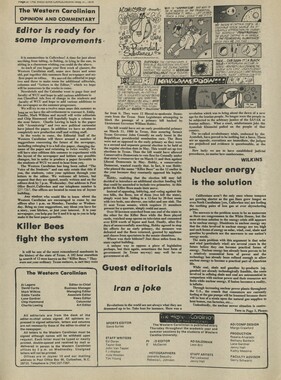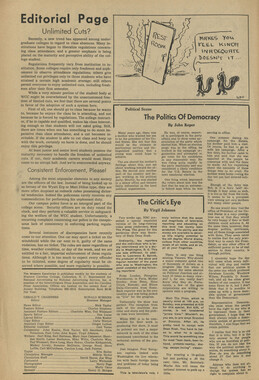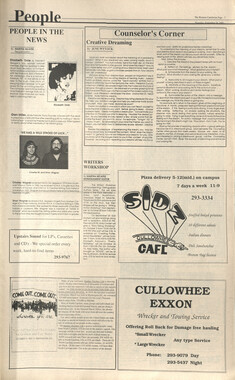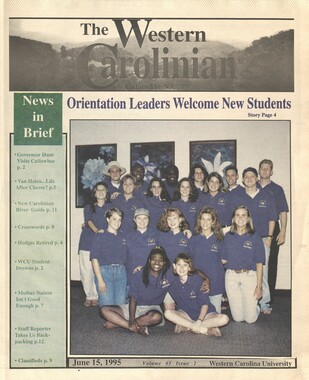Western Carolina University (20)
View all
- Canton Champion Fibre Company (2308)
- Cherokee Traditions (291)
- Civil War in Southern Appalachia (165)
- Craft Revival (1942)
- Great Smoky Mountains - A Park for America (2946)
- Highlights from Western Carolina University (430)
- Horace Kephart (941)
- Journeys Through Jackson (159)
- LGBTQIA+ Archive of Jackson County (85)
- Oral Histories of Western North Carolina (314)
- Picturing Appalachia (6873)
- Stories of Mountain Folk (413)
- Travel Western North Carolina (160)
- Western Carolina University Fine Art Museum Vitreograph Collection (129)
- Western Carolina University Herbarium (92)
- Western Carolina University: Making Memories (738)
- Western Carolina University Publications (2491)
- Western Carolina University Restricted Electronic Theses and Dissertations (146)
- Western North Carolina Regional Maps (71)
- World War II in Southern Appalachia (131)
University of North Carolina Asheville (6)
View all
- Allanstand Cottage Industries (62)
- Appalachian National Park Association (53)
- Bennett, Kelly, 1890-1974 (1463)
- Berry, Walter (76)
- Brasstown Carvers (40)
- Carver, George Washington, 1864?-1943 (26)
- Cathey, Joseph, 1803-1874 (1)
- Champion Fibre Company (233)
- Champion Paper and Fibre Company (297)
- Cherokee Indian Fair Association (16)
- Cherokee Language Program (22)
- Crowe, Amanda (40)
- Edmonston, Thomas Benton, 1842-1907 (7)
- Ensley, A. L. (Abraham Lincoln), 1865-1948 (275)
- Fromer, Irving Rhodes, 1913-1994 (70)
- George Butz (BFS 1907) (46)
- Goodrich, Frances Louisa (120)
- Grant, George Alexander, 1891-1964 (96)
- Heard, Marian Gladys (60)
- Kephart, Calvin, 1883-1969 (15)
- Kephart, Horace, 1862-1931 (313)
- Kephart, Laura, 1862-1954 (39)
- Laney, Gideon Thomas, 1889-1976 (439)
- Masa, George, 1881-1933 (61)
- McElhinney, William Julian, 1896-1953 (44)
- Niggli, Josephina, 1910-1983 (10)
- North Carolina Park Commission (105)
- Osborne, Kezia Stradley (9)
- Owens, Samuel Robert, 1918-1995 (11)
- Penland Weavers and Potters (36)
- Roberts, Vivienne (15)
- Roth, Albert, 1890-1974 (142)
- Schenck, Carl Alwin, 1868-1955 (1)
- Sherrill's Photography Studio (2565)
- Southern Highland Handicraft Guild (127)
- Southern Highlanders, Inc. (71)
- Stalcup, Jesse Bryson (46)
- Stearns, I. K. (213)
- Thompson, James Edward, 1880-1976 (226)
- United States. Indian Arts and Crafts Board (130)
- USFS (683)
- Vance, Zebulon Baird, 1830-1894 (1)
- Weaver, Zebulon, 1872-1948 (58)
- Western Carolina College (230)
- Western Carolina Teachers College (282)
- Western Carolina University (2008)
- Western Carolina University. Mountain Heritage Center (18)
- Whitman, Walt, 1819-1892 (10)
- Wilburn, Hiram Coleman, 1880-1967 (73)
- Williams, Isadora (3)
- Cain, Doreyl Ammons (0)
- Crittenden, Lorraine (0)
- Rhodes, Judy (0)
- Smith, Edward Clark (0)
- Appalachian Region, Southern (2569)
- Asheville (N.C.) (1923)
- Avery County (N.C.) (26)
- Blount County (Tenn.) (195)
- Buncombe County (N.C.) (1672)
- Cherokee County (N.C.) (283)
- Clay County (N.C.) (555)
- Graham County (N.C.) (236)
- Great Smoky Mountains National Park (N.C. and Tenn.) (519)
- Haywood County (N.C.) (3569)
- Henderson County (N.C.) (70)
- Jackson County (N.C.) (4912)
- Knox County (Tenn.) (35)
- Knoxville (Tenn.) (13)
- Lake Santeetlah (N.C.) (10)
- Macon County (N.C.) (420)
- Madison County (N.C.) (215)
- McDowell County (N.C.) (39)
- Mitchell County (N.C.) (132)
- Polk County (N.C.) (35)
- Qualla Boundary (982)
- Rutherford County (N.C.) (76)
- Swain County (N.C.) (2182)
- Transylvania County (N.C.) (270)
- Watauga County (N.C.) (12)
- Waynesville (N.C.) (86)
- Yancey County (N.C.) (72)
- Aerial Photographs (3)
- Aerial Views (60)
- Albums (books) (4)
- Articles (1)
- Artifacts (object Genre) (228)
- Bibliographies (1)
- Biography (general Genre) (2)
- Cards (information Artifacts) (38)
- Clippings (information Artifacts) (191)
- Copybooks (instructional Materials) (3)
- Crafts (art Genres) (622)
- Depictions (visual Works) (21)
- Design Drawings (1)
- Drawings (visual Works) (185)
- Envelopes (73)
- Exhibitions (events) (1)
- Facsimiles (reproductions) (1)
- Fiction (general Genre) (4)
- Financial Records (12)
- Fliers (printed Matter) (67)
- Glass Plate Negatives (381)
- Guidebooks (2)
- Internegatives (10)
- Interviews (815)
- Land Surveys (102)
- Letters (correspondence) (1013)
- Manuscripts (documents) (618)
- Maps (documents) (177)
- Memorandums (25)
- Minutes (administrative Records) (59)
- Negatives (photographs) (6090)
- Newsletters (1290)
- Newspapers (2)
- Notebooks (8)
- Occupation Currency (1)
- Paintings (visual Works) (1)
- Pen And Ink Drawings (1)
- Periodicals (193)
- Personal Narratives (10)
- Photographs (12976)
- Plans (maps) (1)
- Poetry (5)
- Portraits (4568)
- Postcards (329)
- Programs (documents) (181)
- Publications (documents) (2443)
- Questionnaires (65)
- Relief Prints (26)
- Sayings (literary Genre) (1)
- Scrapbooks (282)
- Sheet Music (2)
- Slides (photographs) (402)
- Songs (musical Compositions) (2)
- Sound Recordings (796)
- Specimens (92)
- Speeches (documents) (18)
- Tintypes (photographs) (8)
- Transcripts (322)
- Video Recordings (physical Artifacts) (23)
- Text Messages (0)
- A.L. Ensley Collection (275)
- Appalachian Industrial School Records (7)
- Appalachian National Park Association Records (336)
- Axley-Meroney Collection (2)
- Bayard Wootten Photograph Collection (20)
- Bethel Rural Community Organization Collection (7)
- Blumer Collection (5)
- C.W. Slagle Collection (20)
- Canton Area Historical Museum (2110)
- Carlos C. Campbell Collection (462)
- Cataloochee History Project (64)
- Cherokee Studies Collection (4)
- Daisy Dame Photograph Album (5)
- Daniel Boone VI Collection (1)
- Doris Ulmann Photograph Collection (112)
- Elizabeth H. Lasley Collection (1)
- Elizabeth Woolworth Szold Fleharty Collection (4)
- Frank Fry Collection (95)
- George Masa Collection (173)
- Gideon Laney Collection (452)
- Hazel Scarborough Collection (2)
- Hiram C. Wilburn Papers (28)
- Historic Photographs Collection (236)
- Horace Kephart Collection (861)
- Humbard Collection (33)
- Hunter and Weaver Families Collection (1)
- I. D. Blumenthal Collection (4)
- Isadora Williams Collection (4)
- Jesse Bryson Stalcup Collection (47)
- Jim Thompson Collection (224)
- John B. Battle Collection (7)
- John C. Campbell Folk School Records (80)
- John Parris Collection (6)
- Judaculla Rock project (2)
- Kelly Bennett Collection (1482)
- Love Family Papers (11)
- Major Wiley Parris Civil War Letters (3)
- Map Collection (12)
- McFee-Misemer Civil War Letters (34)
- Mountain Heritage Center Collection (4)
- Norburn - Robertson - Thomson Families Collection (44)
- Pauline Hood Collection (7)
- Pre-Guild Collection (2)
- Qualla Arts and Crafts Mutual Collection (12)
- R.A. Romanes Collection (681)
- Rosser H. Taylor Collection (1)
- Samuel Robert Owens Collection (94)
- Sara Madison Collection (144)
- Sherrill Studio Photo Collection (2558)
- Smoky Mountains Hiking Club Collection (616)
- Stories of Mountain Folk - Radio Programs (374)
- The Reporter, Western Carolina University (510)
- Venoy and Elizabeth Reed Collection (16)
- WCU Gender and Sexuality Oral History Project (32)
- WCU Mountain Heritage Center Oral Histories (25)
- WCU Oral History Collection - Mountain People, Mountain Lives (71)
- WCU Students Newspapers Collection (1923)
- Western North Carolina Tomorrow Black Oral History Project (69)
- William Williams Stringfield Collection (2)
- Zebulon Weaver Collection (109)
- African Americans (390)
- Appalachian Trail (35)
- Artisans (521)
- Cherokee art (84)
- Cherokee artists -- North Carolina (10)
- Cherokee language (21)
- Cherokee pottery (101)
- Cherokee women (208)
- Church buildings (189)
- Civilian Conservation Corps (U.S.) (111)
- College student newspapers and periodicals (2012)
- Dams (107)
- Dance (1023)
- Education (222)
- Floods (61)
- Folk music (1015)
- Forced removal, 1813-1903 (2)
- Forest conservation (220)
- Forests and forestry (1184)
- Gender nonconformity (4)
- Great Smoky Mountains National Park (N.C. and Tenn.) (181)
- Hunting (45)
- Landscape photography (25)
- Logging (119)
- Maps (83)
- Mines and mineral resources (8)
- North Carolina -- Maps (18)
- Paper industry (38)
- Postcards (255)
- Pottery (135)
- Railroad trains (72)
- Rural electrification -- North Carolina, Western (3)
- School integration -- Southern States (2)
- Segregation -- North Carolina, Western (5)
- Slavery (5)
- Sports (452)
- Storytelling (243)
- Waterfalls -- Great Smoky Mountains (N.C. and Tenn.) (66)
- Weaving -- Appalachian Region, Southern (280)
- Wood-carving -- Appalachian Region, Southern (328)
- World War, 1939-1945 (173)
The Reporter, October 1985
-
The Reporter is a publication produced by Western Carolina University featuring news, events, and campus community updates for faculty and staff. The publication began in August of 1970 and continues digitally today. Click on the link in the “Related Mate
-
-
m H Reporter October 1985 A Weekly Newsletter for the Faculty and Staff of Western Carolina University / Cullowhee, North Carolina TO PAINT WITH FEELING "A painting is its own structure," says Robert Godfrey, Western's new art faculty member and department head. "It has its own language. Sometimes when I'm writing I'll get so involved with being precise I'll lose the poetry. I think painting is involved with poetry, too." Godfrey considers himself a sentimental artist. "Sentimentality is something we've taken out of serious literature and painting," he says. We were afraid of overdoing the sentimental, but Godfrey is not submitting to that fear anymore. He believes in using one's personal experiences and loved ones as the material for art. He is interested in painting with human feeling and passion and empathy. "I'm trying to find the visual symbols for that. We're in such a self-conscious age," he says. The sentimental artist, Godfrey says, "is not interested in transcribing what he sees. Instead, he invents or works from visual memory to get the essence from what he feels. The story must be woven from immediate impressions or recent memory to give the work vitality and animation." To animate the large paintings he has been doing recently with human figures, he uses what he calls a "drawing line," or outline of color, to help emphasize the form and shape of the figure. "It's a way of animating and emphasizing gestures," he says. "Sometimes when you're working on figures, they start to seem dead. The Godfrey with "Night Skaters" (photo by Bill Lyons) drawing line is something to give it life." Such an abstract element conveys something of what it means to paint the figure, he thinks. "Most of my training has been through artists who've gone through an abstract period and were rediscovering the figure," he says. "The work is figurative but still in an abstract context. The vocabulary is still abstraction, with the push and pull of the picture plane being important. The content goes back and forth between the image and the form." He f eels that his work swings between classic and romantic, abstract and figurative. "I have gotten more abstract than I was in the 1970s," he says. "I'm still organizing around color balance. Some of my colleagues went in a more conservative direction, trying to discover classical form and classical proportion and, to a certain degree, a more classical technique, building up paint layers and varnishes like the masters. My handling of paint is derived from the abstract. It's much more immediate, less built up." What he wants to do as a sentimental artist is to take a familiar emotion and make it feel freshly energized and new. A few years ago, he started a series of night paintings, some of which are in the faculty art exhibition showing in the Belk Art Gallery through next week. The scenes are all imaginary, their themes based either on his personal experiences or on memories. The night skaters in the show and a young girl swinging at night are huge, exuberant canvases. "Night Swing" contains a moon, something that used to be considered a no-no in serious painting. "About five years ago I started to put moons in some of my paintings anyway," Godfrey says. As many artists do small studies for large paintings, Godfrey often does a large painting first, usually oil on linen, and then does smaller studies from it. He has done them in silkscreen and other media, including mixed media such as pastel over monoprint, a form often used by Degas. Godfrey joined the faculty at Westminster College in rural western Pennsylvania in 1972. In 1979, when he was supposed to go to Europe on sabbatical, he went instead to New York to help get a new museum off the ground. "Most museums are run by curators, not practising artists," he says. "A group of artists associated with the Blue Mountain Gallery and other co-op galleries wanted to see if it could be done. They wanted to show art that was out of favor with the big museums." That museum, the Artists' Choice Museum, began with group exhibitions in borrowed gallery space. After a couple of years, it was accredited by the Board of Regents and now it is in permanent quarters in Soho. It is run by two boards, one of artists who decide all questions of aesthetics and anotfier of trustees who see to the financial stability. The trustees "include two forrper treasurers from the MUSeum of Modern Art and another from the Metropolitan Museum of Art. In 1982, Godfrey started The Journal of the Artists' Choice Museum, which focuses mostly on representational (as opposed to highly abstract) artists. While he was in New York, Godfrey found himself energized by the excitement, but the result was not a series of urban paintings. Rather he would go out into the country on weekends and paint landscapes, something he had not done before. Only after he returned to Westminster in 1982 did images from the city begin to emerge. Between 1983 and 1985, he worked on the night paintings. His current work usually includes both human figures and landscapes, expressing an interaction of the two. Since coming to Western, Godfrey has been reviewing the regional art scene for the Sunday Asheville Citizen-Times. He has covered shows in Asheville, Cullowhee, and Greenville, S.C. "One of the values of criticism is to inform the public of what you know," he says. "Anybody can say what they like or don't like. What I call ethical criticism, as opposed to just making value judgments, is to try to put an artist in a larger context and, at the same time, bring out the individual quality of the work." DONALD L. LOEFFLER (head, Speech and Theatre Arts) attended the mid-year meeting of the Southeastern Theatre Conference in Atlanta, Ga., Sept. 6-8. Dr. Loeffler chairs the Nominations and Honors Committee. RICHARD S . BEAM (Speech and Theatre Arts) recently attended the annual fall master classes at the Southeast section of the United States Institute of Theatre Technology at Lynchburg College, Lynchburg, Va. JANE HALL (Home Economics) was a guest instructor for the Home Economics Vocational Summer Workshop August 6-10 in Greensboro. Teachers from across the state participated in the Child Care Services course. MARSHA CRITES (CIML) gave a presentation on the AgeLink program September 17 at the N.C, State Conference on Aging, sponsored by the N.C. Division of Aging. Her presen tation was part of a session on innovations in intergenerational programming, and she was assisted by Karen Paquette, a senior majoring in therapeutic recreation. JOYCE FARWELL (Music) a ttended a meeting of the National Association of Teachers of Singing September 17-18 at UNC-Greensboro. Scott Agnew, a graduate student in music, performed in master classes with Martin Katz, an internationally known coach/accompanist. Dr. Farwell and her students also attended a recital given by mezzo-soprano Frederica von Stada. W1LBURN HAY DEN (Social Work) was guest speaker for the Social Work Section at the annual meeting of the N.C. Public Health Association, held at the Inn on the Plaza Wednesday, September 18. DOTTIE TATUM (Elementary Education and Reading) gave a presentation, "Reaching the Client with Special Needs," at the 74th annual meeting of the North Carolina Public Health Association, Inc., Sept. 19 in Asheville. PAT UMFRESS (Modern Foreign Languages) and MARILYN JODY (English) are back from the People's Republic of China, where they taught English as a Foreign Language to students and faculty at the Beijing Institute of Technology. Their team of 20 conducted a four-week workshop for 200 students under the auspices of the International Trans-media American Gateway Program. Because of a medical emergency, they could not continue on to Yinnan University in Kunming, China, for the fall semester, as originally scheduled. Dr. Jody is now recuperating at home from surgery for a ruptured disk. MILES L. ECKARD (Community College Coordinator) conducted a workshop for Gaston College on the characteristics of tomorrow's college students and the impact of new technology and employment trends on program offerings. MIKE CREASON (Health, Physical Education, and Recreation) is one of two nominees for vice president of the N.C. Alliance for Health, Physical Education, Recreation, and Dance. The election will be held at the state convention in Greensboro Nov. 14-16. PENLAND RECEIVES HERITAGE AWARD Western's Mountain Heritage Award was presented by Chancellor Myron L. Coulter to the Penland School of Crafts in Mitchell County during a dinner on Mountain Heritage Day. Penland's director, Verne Stanford, accepted the award for the school. Since 1976, the award annually has recognized those whose activities have helped to preserve and interpret aspects of our mountain heritage. According to a citation read by Dr. Coulter, Penland shares with Western "an appreciation of traditional mountain arts, a concern for mountain people, and an interest in creative approaches to the challenges that face us." The Penland School began in 1923 with an effort by Lucy Morgan to revive the art of hand-weaving. She wanted to bring extra income as well as the pleasure of creating into the lives of homebound mountain mothers. In her dreams, she wrote, she could see "innumerable women in modest mountain homes, happily engrossed in weaving beautiful homespuns in delightful old designs, their worries vanishing, their hopes brightening for their children's futures." She brought three looms from Berea, Ky., where she herself learned to weave, and soon the school was a reality. While it has grown to national and international reputation as a community of artists with instruction in clay, glass, metal, photography, wood, weaving and fabric design, and stone masonry, Penland has stayed close to the people of the region. According to the citation: "Penland's logo expresses its spirit. A spiral like that of the chambered nautilus is enclosed in a rectangle, representing the evolving nature of our individual and collective universes within a framework of order and discipline. Penland is a place that nourishes the very special energies of the creative arts, ... a place that fosters deeper perceptions of self and others. "In this world of increasing technology, Penland School has cultivated the arts of the hands and spirit, the 'high touch' to balance 'high tech' and keep our lives in touch with essential values." CAMPUS EVENTS Recital - Mario Gaetano, percussionist, will perform in a recital of contemporary solo and chamber works Sinday, Oct. 13, at 4 p.m. in the Music-English Recital Hall. The recital will open with Bela Bartok's "Sonata for Two Pianos and Percussion" with Asheville pianists Dewitt Tipton and Suzanne Dixon and Percussionist Byron Hedgepeth. Gaetano will perform "Two Movements for Marimba" by Japanese composer Toshimitso Tanaka and, with Maxie Beaver playing clarinet, David Burge's "Sources III" for percussion and clarinet. Bloodmobile - The American Red Cross bloodmobile will be at the Grandroom of Hinds University Center at Western from noon until 5 p.m. Tuesday through Thursday, Oct. 15-17. The goal is 150 units each day. ANNOUNCEMENTS Would you like to offer a non-credit class this spring? Linda Patton, who coordinates non-credit programs for the Division of Continuing Education, would like an opportunity to consider your ideas for short courses, one-day seminars, or workshops to be presented in Cullowhee, Asheville, or Waynesville. She wants to finalize the offerings by late October, so let her know what your thinking is. CIML has prepared county profiles containing data on population trends, employment, income, agriculture, education, retail sales, and other socio-economic indicators for each of the 28 westernmost counties of North Carolina. They should be especially useful to city and county planners, regional planning commissions, educators, local and elected officials and business people. To obtain free copies, contact the Economic Development Division at ext. 7492. CO-OP SPOTS ON TELEVISION W LOS-TV has developed and is now airing a new TV spot for the Cooperative Education program at Western. The spot began airing Sept. 15 and will run through Oct. 27. You are most likely to see it on weekdays between 7 and 9 a.m., 5 and 7 p.m., or 11 and 11:30 p.m. or on weekends between 3 and 7 p.m. A national ad campaign for Cooperative Education is due to begin Nov. 1. Sponsored by the National Commission for Cooperative Education and the Ad Council, it aims to double the number of participants (250,000 at present) in the Co-op program nationally. Its slogan is "Earn a future while you earn a degree." SEANC VOTES FOR RAISE At the recent convention of the State Employees Association of North Carolina convention, the 1,000 delegates voted to petition the General Assembly for a $2,000 pay raise for each state employee next year rather than an across-the-board raise of 10 percent, which would cost the state the same amount. The state employees reasoned that the lower paid state employees, including some full-time employees with annual salaries below the federal poverty level for a family of four, are having difficult times and must seek food stamps and welfare assistance. A 10 percent across-the-board raise gives an employee whose salary is $25,000 per year $2,500 more, but an $8,000 employee receives only an $800 raise. In another heavily debated action, SEANC voted in a flat-rate dues structure of $24 per year for its 50,000 members, instead of a graduated dues structure based on salary. Eight WCU staff members were among the delegates representing District 15 at the convention. They were Helen Swayngim, Virginia Clark (retired), Bonnie Hooper, Mim Mat us, Harriet Parker, Jim Rowell, Carolyn Wiggins, and Mildred Wilson. Members in District 15 are now selling tickets to the Appalachian State-WCU football game to be played Nov. 9 in Cullowhee. The proceeds are used for the district's scholarship fund which last year awarded three scholarships. Tickets from the SEANC members will cost $7 for adults and $4 for high school age and under. That represents a $2 savings off the regular adult ticket price. The district realizes a profit from each ticket sold. For tickets, call ext. 7436 or 7437. E=3 JL VV^/ VYL LV^/1 October 11, 1985 A Weekly Newsletter for the Faculty and Staff of Western Carolina University / Cullowhee, North Carolina ISOLATING PROTEINS THAT KEEP THE LUNGS WORKING Premature babies, cancer patients, and young children with ear infections all have something in common. Some of their cells' membranes are not functioning as they should. Roger Lumb's research has potential applications to all three cases. It deals with a special type of cell in the lung, called the alveolar type II cell. What he is learning may provide answers to some of these practical problems. "The basic biological question is how membranes are put together and are maintained," Dr. Lumb says. "One of the constant observations about cancer cells is that the cell membrane is Roger Lumb altered in some way." He a nd to isolate Gary Pool, with the help of graduate students and others in Western's biochemistry program, are looking at proteins in the membranes to see how they operate. "We found that we had to do other things first, before we could look at the problem of cancer directly," he says. Dr. Lumb is "guardedly optimistic" that science is beginning to understand cancer. Recombinant DNA technology will break things open, he feels. And when he and his colleagues in this research understand enough about the alveolar type II cells, they may begin to apply what they have learned to the situation in cancer. The lung became a model system for his studies. It was ideal because the lung secretes enormous quantities of a membranous material called pulmonary surfactant. The little folds along the inside of the luig, forming pouches called alveoli, are covered with a layer of water to dissolve examines a sample from the centrifuge used the proteins in alveolar type II cells the oxygen in the air we breathe, so it can be taken up by the blood. The inner lung surface, with all its folds, is as large as a doubles tennis court. But water has a high surface tension (that's why oil beads up on the top when you try to mix it with water). The water's surface tension would cause the alveoli to collapse except for the action of the surfactant. The cells Dr. Lumb is most interested in, the alveolar type II cells, contain entities called lamellar bodies (the round objects in the photograph on page 2). The molecules of these lamellar bodies move to the surface and spread out to reduce the tension so that the exchange of oxygen can take place. Premature babies often suffer from respiratory distress syndrome because their lamellar bodies have not yet developed and the surfactant is not secreted. Their lungs collapse unless oxygen is forced into the airway under continuous pressure. But that treatment damages the ling. Dr. Lumb spent six months last year at the University of California medical school in San Francisco, where doctors are watching the effects of such treatment. They keep track of the babies from their intensive care unit, and they have found that the longer an infant is on a respirator, the more lung problems he or she will have in later life. "If you could squirt surfactant onto the ling surface, you could spare the lung that beating," Dr. Lumb s ays. Work is under way to determine the components of the surfactant. A variety of phospholipids are involved in maintaining the membranous structure. The question is, how do phospholipids get assembled into membranes? The process of construction is continuous, because the average phospholipid doesn't last very long. "It's like building a brick wall and replacing the brick continuously," says Dr. Lumb. In the lung, the phospholipid involved in this process happens to be unique. It goes only to the lamellar bodies and then is secreted. "You can watch it because you know where it's going," Dr. Lumb says. "You can tag it with a radioactive marker and that helps you distinguish it from others." Dr. Lumb and his colleagues are isolating the alveolar cells in tissue cultures and characterizing the proteins involved in the movement of the phospholipids. "We are now at a point where we can go into the cells themselves and do experiments," he says. They can develop antibodies to a specific protein and use them as probes to shut off that protein to see what happens. Such information might help identify what's different about cancer cells. One thing they have already learned is that the surfactant molecule is present in the Eustachian tubes, which connect the throat to the middle ear. The reason young children get ear infections, he says, is that the tube has a small diameter and tends to close up. Perhaps the surfactant is in- An alveolar type II cell, photographed under an electron microscope. The round, onion-like entities are the lamellar bodies that secrete surfactant. volved in keeping it open. Although he published that finding, however, Dr. Lumb is wary of too many promises. "Other than for the sake of the knowledge itself," Dr. Lumb sa ys, "the applications are very unpredictable. You can't tell what might come of it. The basic scientific knowledge is necessary before you can apply anything." He is involved in a project with another scientist in San Francisco who is studying atherosclerosis. "What you have in atherosclerosis," Dr. Lumb sa ys, "is lipids plating out on artery walls. We've got the proteins that move the lipids around— phospholipid transfer proteins." A big factor in Dr. Lumb's work nowadays is Micronet, which is developing as a national model to make university resources available to secondary schools. Through computers in schools all over the state, which connect with Western's mainframe computer via telephone lines, Micronet has enabled high school students to get involved in research by professors, teachers to take courses and exchange resources, and all to gain access to a resource data base that lists books, videotapes, and other helps for teaching and learning about science. THE INIMITABLE HARRY DUKE Almost everybody at Western knows Harry Duke. After all, he's taken pictures of almost everybody on campus at one time or another. But do you know: Harry was born in Scotland and still has a sister living there? Harry graduated from Western after one wartime tour with the Marines and then signed up with the Marine Reserves for a military career on active duty? In the Marines, Harry edited a series of newsletters, some of which won awards? Harry lives in the house where his wife was born and frequently entertains foreign students there, especially on holidays? When Harry retired at the end of August, he said he didn't want any kind of retirement party. He d idn't really suspect anything when he got his usual assignment to take pictures at Campus Capers, where co-workers planned a recognition and gift of a VCR, to which people all over campus contributed. But when he arrived at Campus Capers to be greeted by o ne after another person with "Congratulations, Harry! I didn't know you were retiring!" he began to get suspicious in a hurry. "If you didn't know, why are you congratulating me?" he wondered. Harry may be the only one who was happy when Campus Capers was cut short, just a*s the VCR was presented, by a thunderstorm. "For the first time in my life, I was speechless," he says. "I hate to see a grown man cry." But he enjoys the VCR and the Big Bands videotape very much. To all who contributed, he says a heartfelt "Thank you!" World War II broke out when Harry was a senior in high school in Andover, Mass. His father had emigrated from Scotland to work and play soccer for one of the big textile mills in Lawrence when Harry was just a baby, and a year and a half later sent for his wife and two youngest children. Harry's older sister, who is still Scottish, stayed behind with a relative. On Dec. 8, 1941, Harry joined the Marine Corps with a buddy, Warren Deyermond, who had been a student at WCU. After the war, Harry and Warren both came to Western. In 1948 Harry married Sue Norton, in 1949 he played on the only football team Western ever had to win a conference championship (the North State Conference), and in 1950 he graduated with a certificate to teach grammar grades. He taught in Forsyth County for one year but with three children couldn't afford to keep teaching. He was working for Western Electric when the Marines came to Winston-Salem to start a reserve unit. They got him to reenlist. When they found out Harry was a college graduate, they put him in charge of developing a newsletter. That was the beginning of an editorial career. "I spent about a year making mistake after mistake. Finally I told them if they wanted me to continue I'd like to go to school. They sent me to basic journalism school at Great Lakes, 111. I graduated 13th out of 39 students." Harry worked on newsletters at Camp Lejeune, Iwakuni, Japan (where he played an extra in The Last Voyage, a movie starring Bob Sta ck and Dorothy Malone), Cherry Point, Atlanta, and Vietnam. "In the Marine Corps I was not known as a good writer," Harry says, "but I was prolific. I could put the copy out." The Sea Tiger, which he edited for the 3rd Marine Amphibious Force, won an award for the Pacific area. His last assignment before retiring in 1969 was at Camp Pendleton, Calif. The Duke family returned to Cullowhee to live in a house Sue's father had built some 75 years earlier. Harry enrolled to renew his teaching certificate (which he did), but in the meantime he had started taking photographs for faculty members, working out of a darkroom in Killian. In 1974 he was hired full-time as Western's first official photographer. We know the rest. If you want to talk to Harry about any of these experiences, you can find him at Hardee's almost any morning. He enjoys Hardee's almost any morning. He enjoys sending the rest of us to the office. CAMPUS EVENTS Theatre - Western's University Players will open the Noel Coward comedy Hay Fever Sunday, Oct. 13, with a 2 p.m. matinee in the Studio Theatre, Stillwell Building. The play continues with 7:30 performances Oct. 14-16. All seats are $2. The play revolves around an ultra-Bohemian family headed by a novelist and a retired actress. One weekend each has a guest. Various swaps and flirtations ensue. Reservations: ext. 7491. Music - The university's Concert Choir will present a variety show Friday, Oct. 11, at 7:30 p.m. in the Music-English recital hall. Tickets are $5 for adults and $3 for others. The 37-member choir is producing the show to raise funds for a two-week trip to Europe next summer. The performance will include musical and comedy acts, and songs in many styles—country and Western, popular, contemporary, barbershop quartet, jazz, tap-dance, and rock. Art - A retrospective exhibition in Belk Art Gallery of work by the internationally known designer Rudolph de Harak will open Tuesday, Oct. 15, with a 7:30 slide presentation and lecture by de Harak in the Natural Sciences auditorium. A reception will follow the lecture. Rudolph de Harak has done design work for many institutions and firms, including the Metropolitan Museum of Art and McGraw-Hill publishers, and governments (he designed the U.S. pavilion at Expo '70 in Osaka, Japan). The approximately 65 pieces in the show are on permanent loan to Western. When the show closes here Nov. 13, the exhibition will be available to travel to other sites. Bloodmobile - Don't forget the Red Cross bloodmobile at the U.C. Grandroom Tuesday through Thursday, Oct. 15-17, from noon until 5 p.m. Someone needs your blood! ANNOUNCEMENTS A special spring semester 1986 registration for faculty, staff, senior citizens, and students currently taking a WCU course in evening and Saturday classes on-campus will be held in the Cherokee Room of the U.C. Friday, Nov. 8, from 9 a.m. until 3 p.m. Spring materials and permits may be obtained Oct. 24 or 25 on the second floor of the U.C. between 8:30 a.m. and 4:30 p.m., or from the Registrar's Office after these dates. If not currently enrolled, faculty and staff or senior citizens who wish to take courses spring term must be admitted or readmitted by the appropriate admissions office. Tuition for faculty and staff is remitted after the approved form is filed with the Controller's Office. Western's social work department has received $27,000 from the U.S. Department of Health and Human Services to help train students who specialize in child welfare. The grant supports stipends for students working in child welfare agencies in western North Carolina as part of the field instruction sequence of their curriculum. Last year Western received $14,000 under the highly competitive national program. NEW PHYSICIAN COMES TO WCU Jeff Davis, an internist, has joined the infirmary staff as physician. He replaces Richard Renner, who has retired. A native of Pittsburgh, Dr. Davis received a bachelor's degree from Wheaton College and a medical degree from Hahneman Medical f l»l* College in Philadelphia. He c ompleted an internship and residency at Giesinger Medical Center, a 550-bed regional referral hospital in Danville, Pa. Dr. Davis's specialty is internal medicine and he is particularly interested in working with young people. Many of his patients in Danville, where he worked in intensive care and trauma units, were elderly. "I've always lived near college campuses," he says. "I've taken courses in sports medicine and others related to adolescents, and have enjoyed what work I've done with young people. I'm excited about working with the WCU s tudents and getting used to the new population." H Reporter October 18, 1985 A Weekly Newsletter for the Faculty and Staff of Western Carolina University / Cullowhee, North Carolina STUDYING SOCIAL CHANGE - FIRST HAND As a sociologist, Don Pfost is interested in how political and economic factors shape social problems. Recently he had an opportunity to examine the results in a country where the government is attempting to change the political and economic structure in fundamental ways. other developed countries (in the U.S., 1980 figures are 11 per 1,000 for whites, 21.4 per 1,000 for blacks), but it is an improvement. The delegation learned that polio, once a major problem, has been virtually eliminated since 1982, when the government started a massive vaccination campaign. While there, some of the medical personnel helped administer vaccine. On his first trip outside the United States, Dr. Pfost visited Nicaragua with a medical delegation sponsored by the American Public Health Association. Most of the 24-member delegation were physicians, but nurses and other health care workers were also included. A photo-journalist and sociologist Pfost completed the group. They went with two purposes in mind, Dr. Pfost says. First, they wanted to evaluate and document changes in health care since 1979, the year the Sandinistas overthrew General Anastasio Somoza's government. The Somoza family had ruled Nicaragua since the mid-1930s. Second, they wanted to look at the impact of the contra war on health care. Health care facilities are often the objects of contra attacks, Dr. Pfost says. The delegation interviewed 320 people over a two-week period. They interviewed medical personnel and administrators at health care facilities, people on the street, people in marketplaces, even people where they stopped for a meal. They focused on hospitals, where they talked to patients as well as staff. Several of the delegation spoke fluent Spanish, so no government interpreters were needed, Dr. Pfost says. According to the health care personnel in the delegation, impressive changes indeed have occurred in Nicaraguan health care since 1979. Infant mortality has gone from 121 per 1,000 births to 74 per 1,000 births, they found. That is still not very good compared to the United States and The incidence of malaria has been lowered by eliminating breeding places for mosquitos and also by providing preventive medication, which Dr. Pfost and the delegation members took as a precautionary measure. The number of infants who die from diarrhea— which dehydrates the babies and causes them to lose essential minerals—has been lowered by a program of giving fluids laden with the minerals the babies have lost, he says. According to Dr. Pfost, these changes have occurred partly because there are more health centers and doctors: since 1979, the number of health care centers, outposts, and hospitals has tripled; the number of nurses and health care workers has risen fourfold; the number of physicians has doubled. An added medical school and an increase in students admitted to medical school have helped, he says. In 1982, UNICEF and the World Health Organization gave Nicaragua an award for making the greatest advances in health care by a Third World nation, Dr. Pfost says. But he says the delegation found some of the gains are now being lost because of the contra war. In spite of their commitment to improved health care, the Sandinistas are having to divert resources from health to pay for the war, he says. Some 70 health care workers have been killed, and contra attacks have forced the closing of 59 rural health care outposts, three health care centers, and one hospital, he says. Doctors reported problems getting shipments of medical supplies and equipment, and loans to Nicaragua from international lending agencies have been blocked, Dr. Pfost says. So these economic problems are affecting health care, he says. Although some people they interviewed criticized the Sandinista regime, Dr. Pfost says, "My impression was that the majority of the people of Nicaragua support the Nicaraguan government." He also observed that a number of political parties were active. As a sociologist, he says, "One of the things that struck me was the presence of multinational businesses, especially in Managua, the capital city." He saw operations by Coca-Cola, Pepsi-Cola, Texaco, Exxon, Nissan, and Toyota. "The government is committed, at least in principle, to a mixed economy, both public and private, and about 60 percent of farms and businesses are privately owned," he says. The Sandinistas do have failings, Dr. Pfost says. He criticizes their treatment of the Miskito Indians, who were forcibly removed from their land because it was in a combat area, and their censorship of newspapers and the air waves. In any case, he is glad to have had the opportunity to observe a developing country very different from the U.S. He believes it will enrich his teaching. "When we talk about social change, the family, the political economy, we will be able to make comparisons," he says. HEAD PAPERS NOW AT DUKE The papers of Constance Head are now in the manuscript department of William R. Perkins Library at Duke University. Her diaries, scrapbooks, photograph albums, writings, and related papers have become an unrestricted collection entitled the Constance Head Papers. "Perhaps because of Dr. Head's knowledge of and interest in history, she created a more complete record of her life than do most people," said Robert L. Byrd, curator of manuscripts at the library. "We believe her papers will be of value for historical research as documentation of the daily activities and concerns of a professional woman and scholar of the mid-twentieth century, and we are pleased to preserve the papers here in the Duke University Manuscript Department." Dr. Head, who died last June, was a professor of history and religion at Western and a prolific writer. Byrd said, "I hope that the collection will allow future researchers to know and appreciate Dr. Head as she knew and cared for Ahaz, Justinian II, Pius II, and John Wilkes Booth." These Biblical and historical figures were the subjects of her scholarly research and writing, and she thought of them as friends. She held degrees in divinity and history from Duke University. FACULTY RECEIVE MICROGRANTS Three WCU faculty have been selected to receive the first microgrant awards of the 1985-86 academic year. This University-sponsored program awards funds on a competitive basis to support travel, subsistence, and registration/tuition expenses associated with workshop attendance, short course participation, mini-internships, and other off-campus activities related to teaching improvement. With microgrant support, Michael Dougherty (Human Services) will participate in a training program on cognitive behavior modification. Fran Lovin (Medical Record Administration) will be funded to attend a workshop on CPT-4 physician services and procedure coding, a new kind of medical record classification system. "Cognitive Frameworks and Higher Order Reasoning" will be the topic of the University of Chicago institute in which Jim Addison (English) will participate. Guidelines and timetables for microgrant applications were mailed to all faculty in September. Additional information about the program can be obtained from Martha McKinney in Academic Affairs. CHANCELLOR VISITS CHINA Western's chancellor and director of international instructional programs are visiting China, Hong Kong, Thailand, and Malaysia this month to expand the university's faculty exchange program and discuss cooperative research and technical assistance projects. Myron Coulter and Ellerd Hulbert are spending most of their two-week visit Oct. 15-30 in Kunming, China, the capital of Yunnan Province. Yinnan University and WCU have a faculty exchange program. Dr. Coulter and Dr. Hulbert will discuss with province economic officials the possibility of increased trade between China and North Carolina. Yunnan wants to export raw materials, minerals, and crafts, and to import machinery, goods, and services for industries including telecommunications, mining, metals, electronic, chemical, and forest. "We hope to strengthen our ties with Yunnan University and the province, develop new ties with institutions in Malaysia and Thailand, and expand the educational opportunities of our students and faculty," Dr. Coulter said. "We are attempting to break down some of the barriers to foreign students coming to college in the United States, specifically to Western Carolina University." Dr. Hulbert said, "The university wants opportunities for its students and faculty to learn about non-Western cultures and countries that they may not otherwise get at a regional state university." These include research and educational ties with foreign institutions, "internationalizing" the faculty through exchanges, and having more foreign students on campus. Western now has 100 students from 17 countries, about 2 percent of the total enrollment. Dr. Coulter and Dr. Hulbert plan to visit the Institute of the Nationalities in Kunming, a four-year college for Yinnan's national minorities. "One project we'll discuss is cooperative, long-term research dealing with the national minorities in Yunnan and the Cherokee Indians," Hulbert said. Scholars at WCU and Yunnan would share research methodologies and ways of reestablishing past periods of cultural history. Other scholars may work on a study of lakes to reconstruct the natural history of Yunnan over several million years. To organize and promote the joint research and educational projects, a center for American studies would be set up at Yinnan University and a concentration in Chinese studies at Western. The Yunnan University Press would publish a journal of research and educational materials in English and Chinese, and faculty from each institution would be trained in foreign subject areas. Dr. Coulter has scheduled a one-day stop in Bangkok to explore a three-way cultural research project with Chulalongkorn University, Yunnan University, and WCU. China and Thailand have a common research interest—the largest minority group in Yunnan is Thai. While there, Dr. Coulter will visit the International School of Bangkok, a secondary school for English-speaking students, and the American Alumni Association of Thailand, which advises Thai students on attending American universities and colleges. 'Dr. Hulbert will visit the International School of Kuala Lumpur, in the capital of Malaysia, and the Malaysian-American Commission on Educational Exchange. He will discuss with the National University possible joint research projects on tracing the dispersion of the Malay people. The WCU officials will make stops in Beijing to discuss a faculty exchange program with Beijing Institute of Technology and in Hong Kong to investigate the possibility of setting up general-college classes for U.S.-bound Chinese students taught by WCU faculty. Such a program would be similar to one in Jamaica, where WCU professors teach college courses, and similar to an ongoing Malaysian "junior college" instructional program for Malaysian students planning to attend American colleges. The Reporter is pleased to note the addition of benches along the golf course portion of the fitness trail. Both offer beautiful views for one who pauses to look. RESEARCH APPOINTMENTS AVAILABLE The National Research Council announces Resident, Cooperative, and Postdoctoral Research Associateship Programs for research in the sciences and engineering for 25 federal agencies or research institutions, whose labs are located throughout the U.S. The programs provide opportunities for Ph.D. scientists and engineers of unusual promise and ability to perform research on problems of their own choosing yet compatible with the research interests of the supporting laboratory. Initiated in 1954, the Associateship Programs have contributed to career development of more than 4,000 scientists, from recent Ph.D. recipients to distinguished senior scientists. Approximately 350 new full-time Associate-ships will be awarded on a competitive basis in 1986 for research in: chemistry, earth and atmospheric sciences; engineering and applied sciences; biological, health, and behavioral sciences; mathematics; space and planetary sciences; and physics. Most programs are open to both U.S. and non-U.S. nationals, and to both recent Ph.D. degree recipients and senior investigators. Awards are made for one or two years, but senior applicants who have held the doctorate at least five years may request shorter tenure. Stipends for the 1986 program year begin at $26,350, appropriately higher for senior Associates. A stipend supplement of about $5,000 may be available to regular (not senior) awardees holding doctoral degrees in those disciplines wherein the number of degrees conferred by U.S. graduate schools is significantly below the current demand. In the 1985 program year these areas have been engineering, computer science, and space-related biomedical science. Reimbursement is allowed for some relocation costs and professional travel. The host lab provides programmatic assistance including facilities, support services, necessary equipment, and travel necessary to conduct the approved research program. Applications to the National Research Council must be postmarked no later than January 15, 1986 (April 15 and August 15 for later competitions). Initial awards will be announced in March and April (July and November for the two later competitions), awards to alternates later. For applications and information on specific opportunities and federal laboratories, write: Associateship Programs, Office of Scientific and Engineering Personnel, JH 608-D1, National Research Council, 2101 Constitution Avenue, N.W., Washington, D.C. 20418, (202) 334-2760. CAMPUS EVENTS Homecoming - Next weekend! Watch calendar. Art - Opening Wednesday, Oct. 23, with a 7 p.m. reception in Chelsea Gallery will be an exhibition of figurative sculptures and drawings by Rodney Shaw. A graduate of the University of Chicago with a doctorate in art history, Shaw maintains a studio in Burnsville. He sa ys of his work: "The difficulty with a more or less naturalistic piece is that if it isn't good, it's just awful. With a great deal of work and strict attention you may be fortunate and get it, and not obscure it by inappropriate details, or maladroit proportions, or clumsy surfaces, or goofy colors." BISHOP IS EOP FOR OCTOBER Western's chapter of the N.C. Association of Educational Office Personnel highlights Virgie Bishop as its featured Educational Office Person for the month of October. A graduate of Sylva High School, Virgie has worked as a clerk-typist in the Book Rental department of the WCU Book Store for 16 years. "The thing I enjoy most about my work," she says, "is working with the students. Virgie is a member of the N.C. State Employees Association as well as NCAEOP. She enjoys travel, needlecraft, cooking, refinishing antiques that she buys and sells, and mining rubies and other gem stones. She and her husband, Fred, who is retired from the Department of Transportation, have a son, Fred Jr., who graduated from Western in 1972. f==J Reporter October 25, 1985 A Weekly Newsletter for the Faculty and Staff of Western Carolina University / Cullowhee, North Carolina LOOKING AT PLANTS AND THE IMPACT OF ENVIRONMENTAL CHANGE This time of year, we usually see Dan Pittillo quoted in the region's newspapers on the fall leaf show. He's the one they often call to find out how brilliant the trees will be and when the color will peak. They haven't called this year, but Dr. Pittillo's name is in the news anyway. Not only is he active in the North Carolina Bartram Trail Society, which just had its annual meeting in Highlands, taut he's trying to alert people to a choice currently before the federal government on sites that might be used to bury high-level nuclear wastes. Last year he served on a study panel for the North Carolina Academy of Sciences, which was asked by the state government to evaluate the suitability of sites within the state. rock in Nevada, and basalt in Washington state. The North Carolina sites are crystalline rock formations. Dr. Pittillo and the panel felt that these might not be safe because they are probably highly fractured by faults and subject to further faulting. The exceptionally high rainfall here would also affect the safety of the deposits, Dr. Pittillo says, both because rain contributes to rock fracturing and because we are near the Eastern Continental Divide, with waters going to both the Gulf of Mexico and the Atlantic. If leaks occur, water would be contaminated anywhere below, he says. There will be a public forum on this issue Nov. 4 at 7 p.m. in Forsyth Auditorium, with several faculty members participating. This fall the federal government is deciding which sites will be used, and Dr. Pittillo fears that one in western North Carolina may well be chosen. The reasons have more to do with convenience and logic than actual safety, he says. Since most of the material to be stored would be generated at the nuclear facilities in Oak Ridge, Tennessee, and the Savannah River Plant in South Carolina, western North Carolina would be the most convenient place in the Southeast to store it. Anywhere else would require transportation across more than one state line. In addition, Governor Jim Martin has said he would not veto a site in North Carolina, if chosen, and there is considerable opposition to sites in the more heavily populated North Carolina Piedmont. Western North Carolina, on the other hand, needs jobs and so far has shown little resistance to a site in this area, Dr. Pittillo says. A first round of sites already recommended include salt deposits in Texas, volcanic In the early 1970s, after he had been in Cullowhee a few years and gotten settled in, he began to realize that several natural areas he wanted to study were bearing the impact of pollution and development. Now, besides working with the Bartram Trail Society, which he headed for six years, and editing Castanea; The Journal of the Southern Appalachian Botanical Club, he edits the Conservation Newsletter for the Highlands Biological Foundation and worked on the state's first official list of rare and endangered plant species. Now he realDr. Pittillo is one of those people whose professional interests spill over into their personal lives. He does not consider himself an ecologist, but as a botanist he is concerned with the environmental conditions that affect the plants he studies, and it has made him something of an activist. "I am a conservationist," he says, "and I am very concerned about our region." ly enjoys finding a rare plant in a new place. Dr. Pittillo had begun to catalog plants in 1954 as a sophomore in high school, when his biology teacher suggested he help collect specimens for a flora, or list of plants, for North Carolina. He helped with the Henderson County plants and is credited in A Manual of the Vascular Flora of the Carolinas. Then, as a student at Berea College, he helped collect plants under a U.S. Forest Service grant. He would spend the weekend in the Berea Forest collecting, then work at pressing, drying, and labeling during the week. He and a high school teacher there collected about 600 plants. Now Dr. Pittillo's biggest professional interest is pollen research, in which he is cooperating with Paul and Hazel Delcourt at the University of Tennessee. A paper he and Hazel Delcourt wrote last year won the Annual Research Award of the Association of Southeastern Biologists. What they have been working to establish is some reliable guide for determining former species in a place by comparing the pollens deposited as sediment in ponds, lakes, and bogs. Some pollens blow too far to be reliable guides for a limited area, Dr. Pittillo says. The high reaches of the mountains are the areas they are most interested in, Dr. Pittillo says. They are trying to establish that tundra once existed there, at elevations above 4,500 feet. "Apparently during the glacial periods (from 14,000 to 25,000 years ago), the highest mountains got denuded of forest," Dr. Pittillo says. There are boulder fields and other "peri-glacial" features that indicate the presence of tundra before the warming periods and great deluges of rain changed the climate again. During a trip to Alaska with colleague Oim Wallace a few years ago, he saw some plants that still exist in the high elevations here. To determine what once existed, he and the Delcourts can examine samples of pollen deposited in silt beds to determine, on the basis of the reliable species, what once grew in a particular area. They have been especially interested in the area around the Blue Ridge Parkway campground at Mt. Pisgah. There, when the permafrost melted, silt and debris avalanched into the wide basin. Now a complete heath community grows there and the pollen record shows that it has been there for more than 3,300 years. Among the members of the heath family now present are blueberries, rhododendron, mountain laurel, and azalea. Two woody heaths—andromeda, or bog rosemary, and leatherleaf—once grew there but are no longer present. "We think it's the oldest pollen record for heath," Dr. Pittillo says. Dr. Delcourt's data would relate to conditions that existed before so many trees died at Richland Balsam on the Parkway. She collected her data in 1978, when most were still living. The trees were killed by the balsam wooly aphid, Dr. Pittillo says, but they may have been under stress from pollution and thus more susceptible. Among his upcoming projects is a contract to identify important plant habitats for the Blue Ridge Parkway, identifying places and defining their importance for endangered and threatened species; some sites will be important because the plants are rare for the Parkway area, some because the plants are especially showy. Dr. Pittillo recently wrote a chapter on a book for the Parkway, and his thesis was that the plants are the prime attraction for parkway visitors. "The greatest visitation is during the color season in the fall," he says to prove the point, though we sometimes take the plants for granted. (And on the subject of autumn leaves, Dr. Pittillo offers his professional opinion: the color has been as good as last year, maybe even more intense, since late-turning trees like red oaks are changing before some of the earlier ones, like yellow poplars, have dropped all their leaves.) BARBARA MANN and STARLETT CRAIG (Student Development) made a research presentation at the conference of the N.C. Association of Women Deans, Administrators, and Counselors Sept. 19-20 in Raleigh. Their topic was "Leadership Style as a Function of Androgyny and Gender in Matched Pairs of Higher Education Professionals." SHIRLEY KOOL (Student Financial Aid) also attended. PUBLIC RADIO IS COMING Used to be, if you moved to Jackson County from downstate or east Tennessee or a lot of other places, you lost the opportunity to turn on your FM radio and hear fine music or "All Things Considered" or "Prairie Home Companion." Soon, that loss will be history. Thanks to the efforts of Western North Carolina Public Radio, Inc. (WNCPRI), WCQS-FM will be broadcasting not only to Asheville listeners but to listeners in Webster, Cullowhee, Sylva, and Dillsboro. WCQS-FM ("Western Carolina's Quality Sound"), now owned and operated by WNCPRI, was formerly WUNF-FM when the station was owned and operated by UNC-Asheville. The new arrangements result from an effort that began in the mid-1970s, one in which Western has been very much involved. At that time the N.C. Task Force on Public Telecommunications was at work under the chairmanship of Herbert L. Hyde, a WCU graduate. As a result of the task force's recommendations, the Agency for Public Telecommunications was created, and one of its functions was to support the development of public radio across the state. Meanwhile, several individuals at Western had become interested in public radio and they began exploring the possibilities for this area. Jack Manock and Doug Reed went to meetings across the state and, according to Reed, "The interest in public radio on the campus sort of smoldered along." Later, H.F. Robinson, then chancellor, appointed a committee to study what Western should do to assist in developing public radio west of Asheville. Reed was chairman. Beginning in 1980, university representatives had a number of discussions with Frederick Dennis, who headed a group in Asheville working for public radio. That group had incorporated in 1979 as WNCPRI; one of its members was William Highsmith, then chancellor of UNC-A. Among the matters discussed was the need for public radio west of Asheville. Hyde's task force, recognizing the problems for an FM signal in mountainous terrain, which interferes with the signal transmission, had recommended a station in Asheville and one somewhere west of Asheville. At that time it was not common for an FM station to have translator or repeater stations. In 1981, Reed and Harry Ramsey appeared before the board to formally request that efforts in Asheville and efforts west of Asheville be combined. By this time, it was apparent that the Agency for Public Telecommunications was not going to be successful in getting funding, and people were asked to seek funding independently through their state legislators. By combining efforts, public radio advocates in the western part of the state could avoid duplicate requests to the same lawmakers. Shortly thereafter, Reed was elected to the WNCPRI board. Western has provided financial support to the corporation, as well as other support. Chancellor Myron Coulter has continued and increased the university's involvement begun by Dr. Robinson. Reed has spent a substantial amount of time working with the group; formerly he chaired the finance committee and recently he was reelected vice-chairman of the board. He a lso is a member of the executive committee. The board recently went from 19 to 25 members, and another Jackson County resident, Vicki Greene Dowling of Dillsboro, was named as a member. As a result of all these efforts, public radio in western North Carolina is in the midst of an enormous expansion in service. Originally, WUNF-FM was a student station at UNC-A with a very limited audience. Since the license was transferred to the corporation, the signal has been increased to cover Buncombe and part of Henderson, and translators for Haywood and Jackson counties will be in place by spring. Plans include carrying the signal to counties west of Jackson, as well as Transylvania and Madison counties, in the future. Where is the money coming from? WNCPRI received a grant of $133,000 through the Corporation for Public Broadcasting to serve a wider area of the state by extending the signal and building the translators. The General Assembly has provided funds, most recently $50,000 for 1985. Other funding has come from Western, UNC-A, the Z. Smith Reynolds Foundation, the Jinior League of Asheville, the Community Foundation of Western North Carolina, and the Grass Roots Arts Program of the Community Arts Council of Western North Carolina. The WNCPRI budget for 1985 includes $132,000 for operating expenses and a capital budget of $417,736, Reed says. Oust a few years ago the budget was about $30,000. The station is licensed as "community-based public radio," not university-based, and during the past year about 46 percent of operating income has come from listeners. The rest comes from grants and foundations, Reed says. Like most public radio, WCQS accepts no advertising but mentions underwriters for specific programs. Until recently, all programming originated locally or was syndicated. On Oct. 1, the station began broadcasting programs from the National Public Radio and American Public Radio networks, including the popular shows "All Things Considered" (daily at 5 p.m.) and "Prairie Home Companion" (Saturday evenings). Because UNC-A is remodeling Lipinsky Building, where the station had been housed, it recently moved into new quarters at 73 Broadway in Asheville. The space is being provided rent-free for one year by architect John Reid. Volunteers have worked hard to put up sheetrock walls and remodel the space for use by the station. CAMPUS EVENTS Theatre - The National Shakespeare Theatre will perform A Comedy of Errors in Hoey Auditorium Tuesday, Oct. 29, as part of the Lectures, Concerts, and Exhibitions series. Shakespeare's first comedy matches wits of two sets of identical twins. Brother is mistaken for brother, servant for servant, stranger for husband, lover for in-law, and sanity for madness. Tickets are $5 for adults, $2 for non-WCU students, and $1 for WCU s tudents with I.D. The theatre company has been bringing live professional theatre to communities all across the United States for more than two decades. Each year the touring company travels over 35,000 miles, visiting hundreds of cities and performing Shakespeare's plays for over 75,000 people. It also operates the Cubiculo Performing Arts Center in a handsome five-story brownstone in New York's theatre district. Concert - Classical guitarist Giovanni DeChiaro will perform here Thursday, Oct. 31, also as part of the LCE series. The concert will begin at 8 p.m. in the Music-English Recital Hall. A member of the music faculty at the University of Southern Mississippi, he made his Carnegie Hall debut in 1976 and has been selected as a young artist of the year by a national music journal. He will play baroque and 19th century Spanish works as well as works by 20th-century composers. Tickets are $5 for adults, $2 for non-WCU students, and $1 for WCU students with I.D. Theatre - Jean Kerr's clever comedy of the eternal quadrangle comes to the Little Theatre stage next week when the University Players perform Lunch Hour. Show time is 7:30 p.m. Friday and Saturday Nov. 1-2 and Wednesday through Saturday Nov. 6-9. There is a 2 p.m. matinee Sunday, Nov. 3. Two couples, an affair, an imagined affair, a marriage counselor, a millionaire, and a kooky actor are the ingredients of this witty entertainment. Tickets are $4 for adults, $3 for students and elders, and $2 for children. All seats are reserved. For reservations, call ext. 7491 or 7365. ANNOUNCEMENTS Registration - Western's first computer registration will occur Tuesday-Thursday, Nov. 5-7. Video monitors will allow students to tell quickly which classes are available to them and get their schedules. Chorus to Form - The Western Carolina Community Chorus will hold an organizational meeting and its initial rehearsal for the 1985-86 season at 4 p.m. Sunday, Nov. 3, in 357 Music-English. The chorus will begin preparation on the Verdi Requiem, which is to be performed with the Asheville Symphony Orchestra in April 1986. Founded in 1970, the group draws its membership from the state's westernmost counties and performs throughout the region. It is sponsored by WCU and the Jackson County Arts Council and is directed by James Dooley. All interested singers should attend.
